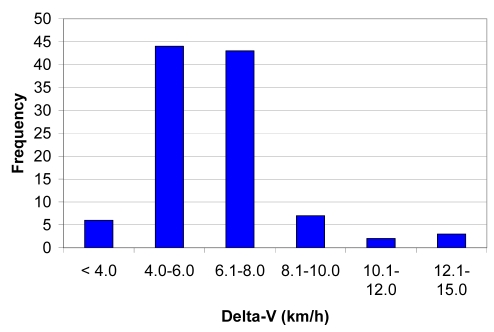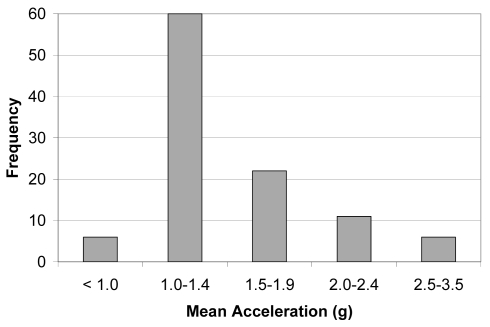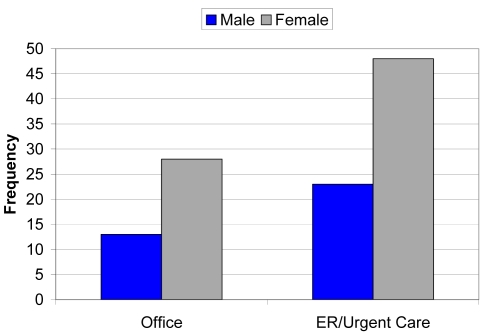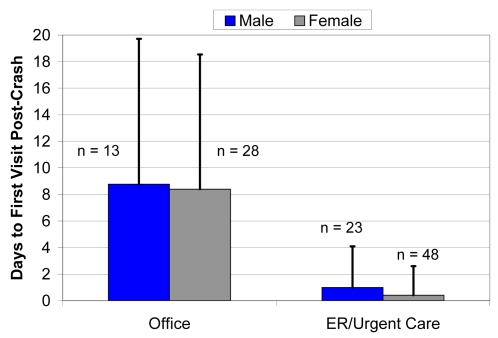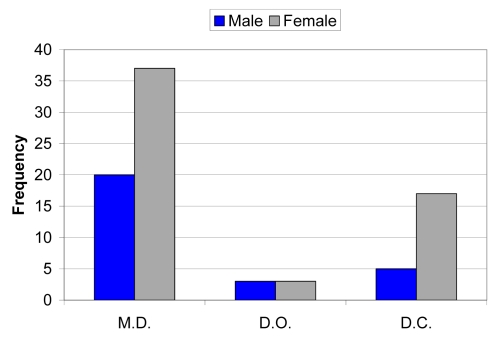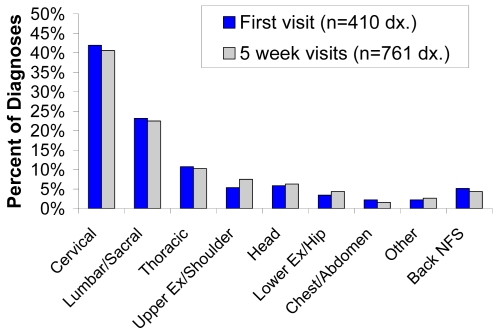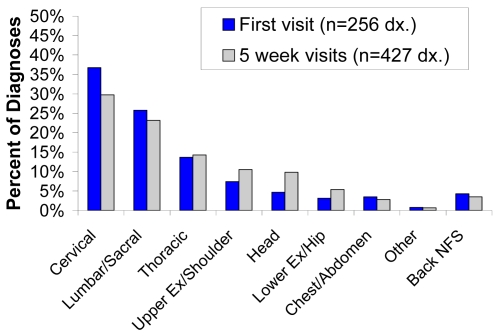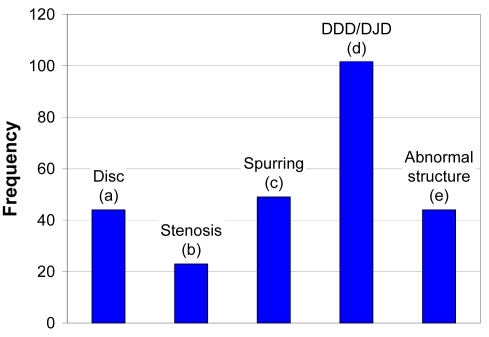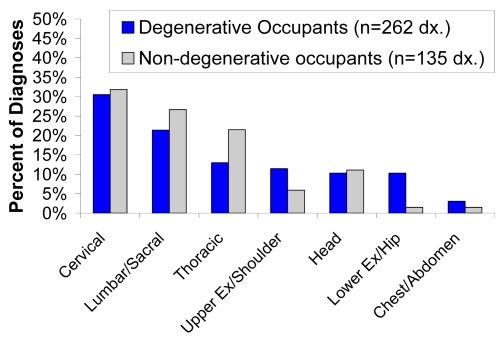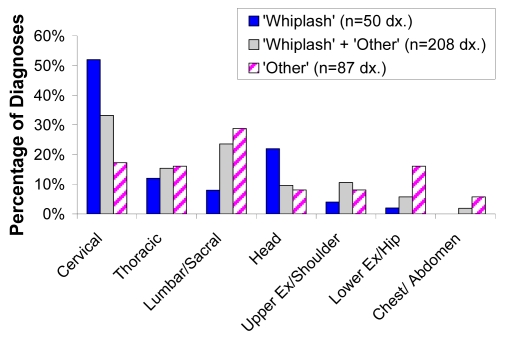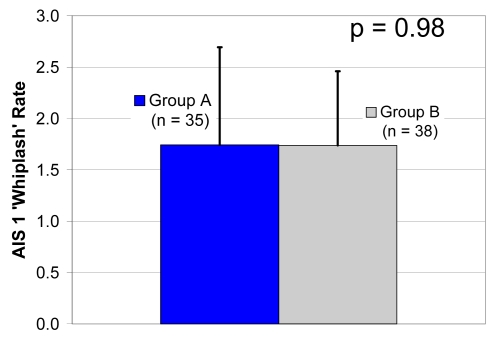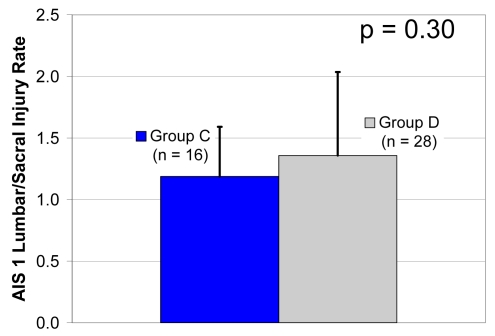Abstract
In the United States there is currently a paucity of available real world minor rear crash data with struck vehicle delta-V, or speed change, less than or equal to 15 kilometers per hour. These data are essential as researchers attempt to define ‘whiplash’ injury risk potential in these minor crashes. This study analyzed a new set of 105 U.S. minor rear aligned crashes between passenger vehicles. Mean struck vehicle delta-V and acceleration were 6.3 km/h (s.d. = 2.1 km/h) and 1.4g (s.d. = 0.5g), respectively. A total of 113 struck vehicle occupants were diagnosed within five weeks post-crash with 761 ICD-9-CM complaints and 427 AIS injuries (99.5% AIS1) attributed to the crashes. No striking vehicle occupants reported complaints. The main ICD-9-CM diagnoses were 40.6% cervical, 22.5% lumbar/sacral and 10.2% thoracic and the main AIS1 diagnoses were 29.7% cervical, 23.2% lumbar/sacral and 14.3% thoracic. The diagnosis disparity was mainly due to coding for pre-existing degenerative diagnosis in ICD-9-CM. Degenerative spine conditions were not significant for increased AIS1 injury risk. Surprisingly, many non-‘whiplash’ diagnoses were found. The AIS injury diagnosis distribution and frequency in these minor delta-V crashes did not correspond with previous minor rear crash studies. A prospectively collected and unbiased minor rear crash databank in the model of CIREN or NASS is highly desirable to verify or refute these results for the U.S. population since the current study cohort may have been influenced by litigation.
INTRODUCTION
Currently in the United States there exists a paucity of real world minor rear aligned crash data for crashes with struck vehicle delta-V less than or equal to 15 km/h. While previous large-scale retrospective studies from Germany (Eis et al., 2005; Hell et al., 2002) and a prospective study from Sweden (Krafft et al., 2005) have examined the relationship between minor rear crash struck vehicle delta-V and risk of occupant ‘whiplash’ complaints, no large scale studies exist for U.S. minor rear crashes.
Eis et al. (2005) examined the German In-Depth Accident Study (GIDAS) and found that for single rear impact crashes involving 1,724 struck vehicle occupants, 59% of occupants were uninjured and 39% sustained a maximal AIS1 (Association for the Advancement of Automotive Medicine, 2005) injury. Of the AIS1 injured occupants, injury data for crashes with engineering-reconstructed struck vehicle delta-V less than or equal to 15 km/h were available for 314 occupants. For these 314 occupants claiming injury, 69% had AIS1 neck injury, 16% had no neck injury and 15% had AIS1 neck injury in addition to ‘other’ injuries. Hell et al. (2002) analyzed crashes from the Gesamtverband der Deutschen Versicherungswirtschaft (GDV) database. These authors found that of 88 occupants alleging ‘whiplash’ injury in struck vehicles with PC-Crash reconstructed delta-V less than or equal to 15 km/h, all had grade 0, 1, 2 or 3 ‘whiplash associated disorders’ (WAD) according to the Quebec Task Force (Spitzer et al., 1995). Krafft et al. (2005) conducted a study of Swedish crashes pooled from more than 60,000 vehicles equipped by Folksam Insurance with event data recorders (EDR). From these vehicles, a total of 171 struck vehicle occupants were involved in rear crashes with EDR recorded delta-V less than or equal to 15 km/h. Of these struck vehicle occupants claiming injury, 67% had no ‘whiplash’ injury, 26% had AIS1 ‘whiplash’ injury for less than one month post-crash and 7% had AIS1 ‘whiplash’ injury for longer than one month post-crash. Of particular note to the current study was that in both of the minor rear crash German studies and the Swedish study, the authors made no mention of any claimed or diagnosed struck vehicle occupant injuries to the thorax, abdomen, thoracolumbar spine, upper extremities or lower extremities.
There are few U.S. minor rear crash data to directly compare with the aforementioned European studies since no dedicated minor crash database collection currently exists in the U.S. One published retrospective U.S. minor rear crash study (Tencer et al., 2001) had a sizeable study cohort relating engineering reconstructed struck vehicle delta-V to occupant injury complaint frequency. A total of 432 struck vehicle occupants, previously diagnosed with ‘whiplash’ attributed to rear crashes with peak delta-V less than 11.3 km/h, were analyzed. All subjects were proceeding to litigation. Immediate symptoms were considered but the specific number of days between the crash and symptom onset was not reported. A total of 174 subjects had AIS1 neck and upper back pain at mean delta-V of 8.0 km/h (s.d. = 2.1 km/h), 174 subjects had AIS1 neck and low back pain at mean delta-V of 7.7 km/h (s.d. = 2.9 km/h) and 84 subjects had AIS1 neck pain and arm symptoms at mean delta-V of 8.8 km/h (s.d. = 5.0 km/h). The authors concluded that pre-existing lumbar degeneration was associated with (a) having arm symptoms or (b) AIS1 low back pain with neck pain. While the entire study cohort reported AIS1 neck pain, there were no reported head, thorax, abdominal or lower extremity complaints.
While much can be learned from the prior studies, further U.S. minor rear crash analysis is needed in order to develop an understanding between struck vehicle delta-V, transient and chronic occupant ‘whiplash’ complaint risk. The lack of available U.S. data is particularly startling when considering that the National Highway Traffic Safety Administration (NHTSA) estimates that approximately 806,000 occupants sustain ‘whiplash’ injuries in motor vehicle crashes producing modern day economic and quality of life costs over $9 billion yearly (Kuppa, 2004). Over the past six decades, much has been done to improve the understanding of specific ‘whiplash’ injury mechanisms, patient treatment protocols, and vehicle bumper, seat and head restraint designs. Yet, even with the voluminous amount of research in the engineering and medical fields, ‘whiplash’ injuries in rear crashes have increased since the 1960’s (Kahane, 1982; National Highway Traffic Safety Administration, 2004). Furthermore, insincere or inflated minor crash injury claims under the U.S. tort system have been cited as a contributor to current excess health care costs of approximately $5.8 billion and increased insurance premiums of $19 to $26 billion yearly (Carroll et al., 1995).
In the current study, a newly collected minor rear crash forensic engineering data set was analyzed. Crash data were sought from forensic engineering sources since this is one of the few sources of large numbers of minor rear crashes in the U.S. The study intended to be a first step in answering several fundamental questions regarding minor rear crashes and ‘whiplash’ in the U.S. Primarily, what are the delta-V and mean acceleration associated with diagnosed complaints, including ‘whiplash’, in minor rear crashes in the U.S.? Secondly, what is the complaint diagnosis distribution in these crashes based on ICD-9-CM (U.S. Department of Health, 1979) and AIS coding? Thirdly, can currently known minor rear crash injury mechanisms explain the ICD-9-CM and AIS coded diagnoses in these crashes? And lastly, does ICD-9-CM coding from medical records differ when compared with AIS coding? Armed with answers to these fundamental questions, safety engineers and clinicians alike will be able to design vehicle systems to reduce ‘whiplash’ incidence, develop improved treatment protocols to specifically target the most frequently injured body locations in minor rear aligned crashes, improve insurance claims processing for legitimate minor rear crash injury and more efficiently identify and remedy potentially disingenuous minor rear crash insurance claims.
METHODS
The authors sought real world minor U.S. rear crashes via (I) a database search and (II) a review and analysis of crash files from a forensic engineering company. Inclusion criteria for the current study limited data to (a) U.S. real world rear crashes, (b) crashes between two passenger vehicles with gross weight less than 4,536 kg for each vehicle, (c) single contact between the front of the striking vehicle and rear of the struck vehicle, (d) aligned contact between the two vehicles, (e) full overlap between the two vehicles, (f) crash occurring on a flat roadway, (g) reconstructed struck vehicle delta-V less than or equal to 15 km/h and (h) medical documentation of post-crash occupant complaint diagnoses for visits to a medical doctor (M.D.), osteopathic doctor (D.O.) or chiropractor.
(I) Database search
A database search for U.S. real world minor rear crashes was conducted. The Crash Injury Research Engineering Network (CIREN), National Automotive Sampling System Crashworthiness Data System/General Estimates System (NASS), Fatality Analysis Reporting System (FARS), Special Crash Investigations (SCI) and the National Trauma Databank (NTDB v6.2) were searched for all data available as of 2007. These databases were generally predisposed to higher energy towaway crashes with serious injuries, or had limited information on minor rear crashes.
(II) Forensic engineering analysis
Since the database and literature search yielded a small data set from which to study minor rear ‘whiplash’ crashes, real world crash files from a forensic engineering company in the U.S. were examined for crashes occurring from 1994 to 2006. In all crash files, occupants filed at least one property damage or injury claim with a U.S. insurance company and were potential litigants in a U.S. court. These files included available vehicle and scene inspections, police reports, insurance repair estimates, occupant medical records and occupant statements utilized for an engineering crash reconstruction. From these files, 105 minor rear aligned crashes from 15 states met the inclusion criteria. These crashes involved a total of 126 occupants in the striking vehicles and 151 occupants in the struck vehicles. Front seat struck occupants totaled 137 persons. A total of 113 struck vehicle occupants were diagnosed with complaints attributed to the crash within five weeks post-crash by a M.D., D.O. or chiropractor. No striking vehicle occupants reported injury complaints or sought medical treatment post-crash.
For the 113 struck vehicle occupants, medical records were examined for complaint diagnoses within five weeks post-crash. These records were obtained according to the U.S. Health Insurance Portability and Accountability Act (HIPAA) requirements (United States Department of Health and Human Services, 1996). Additionally, these records were redacted such that all occupant-specific identifiers were removed. Unique claimed complaint and injury diagnoses were compiled for this period based on International Classification of Diseases 9th Edition-Clinical Modification (ICD-9-CM) and Abbreviated Injury Scale 2005 (AIS) coding requirements. A unique ICD-9-CM diagnosis was defined as any distinctive diagnosis given to the occupant during the five week treatment period. Thus, the occupant could be diagnosed with a cervical sprain repeatedly during visits to different clinicians, but this diagnosis would only count for the first visit when it was originally diagnosed. Unique AIS diagnoses differed slightly from ICD-9-CM in that AIS codes included only acute injuries. Pain diagnoses were recorded as AIS1 injuries. Each crash was individually reconstructed and the struck vehicle delta-V and acceleration were calculated. The minor crash reconstruction methodology utilized follows.
Crash reconstruction
Reconstruction methods in aligned crashes between two vehicles utilize fundamental physical collision properties to determine vehicle delta-V and mean acceleration. The impulse-momentum relationship, energy balance relationship, normal force restitution and kinematic equations of motion for the vehicles can be used to solve for delta-V and mean acceleration:
Impulse-momentum relationship
| (1) |
Energy balance relationship
| (2) |
| (3) |
Kinematic equations of motion
| (4) |
| (5) |
| (6) |
Restitution
| (7) |
Where:
mi =vehicle ‘i’ mass (kg)
v1i =vehicle ‘i’ pre-crash velocity (m/s, ‘i’ = 1,2)
vi2 =vehicle ‘i’ post-crash velocity (m/s, ‘i’ = 1,2)
ai = vehicle ‘i’ average acceleration (m/s2)
Δxi = vehicle ‘i’ linear displacement from impact area to final rest position (m)
Δvi = vehicle ‘i’ velocity change (m/s)
Δt = impact duration (s)
e =restitution coefficient for crash contact
BEVi =vehicle ‘i’ barrier equivalent velocity (m/s, ‘i’ = 1,2)
∫12FTdt= impulse integral of vehicle tire forces over contact duration for both vehicles (N−s)
∫w1w2 ∫C1C2 FCi dCdw=vehicle ‘i’ energy expenditure during crash due to contact forces, crush depth and vehicle width (N−m, i = 1,2)
In the current study, delta-V and average acceleration were used to quantify crash severity as these parameters have been most often used in prior studies (Krafft et al., 2005; Eis et al., 2005; Siegmund et al., 2005). Delta-V is different than barrier equivalent velocity (BEV). BEV is a derived quantity relating permanent crush deformation energy in a real world crash to the same type of vehicle in a controlled barrier crash test. The BEV is equal to the barrier impact speed and can be calculated as shown in equation (3). Given the same real world and crash test vehicle with similar crush profiles, the real world vehicle BEV and energy dissipation is approximately the same as the crash test vehicle.
Higher energy crash reconstruction methods are utilized when there is an appreciable amount of crush for both vehicles in the crash, when crashes can be treated as plastic collisions, while restitution is ignored and tire force impulse can be neglected (Campbell, 1974; Strother et al., 1986). Vehicle velocities are generally determined from equations (1) through (3), with collision energy calculated from NHTSA frontal or rear barrier crash tests with nominally 25 to 50 cm of crush.
Minor crash reconstruction estimates
Often after minor rear crashes, there is minimal or no crush to one or both vehicles. Thus, when crush is absent post-crash, one cannot determine BEV or energy expended based on crush as is done in higher energy crashes. One possible solution for this problem has been to assume a small crush that is not actually present and use this value with the vehicle stiffness to calculate a BEV (Cipriani et al., 2002). Unfortunately, assuming a small crush amount overestimates minor crash delta-V in vehicle-vehicle impacts by an average of 110% for delta-V from 1.8 km/h to 15 km/h. Furthermore, computer crash reconstruction programs, such as m-SMAC, m-CRASH, WinSmash, Crash3, and HVE-EDCRASH use algorithms based on barrier crash tests and require measurable crush in order to determine vehicle delta-V. These programs are not validated for minor crashes; the inaccuracy of computer crash reconstruction programs for minor crashes has been shown previously (Niehoff and Gabler, 2006).
Thus, accurately estimating minor crash delta-V requires a different reconstruction methodology than that classically used in higher energy crashes. In minor crashes, one can still apply methods shown in equations (1) through (6), but the vehicles are assumed to behave elastically. This means that the restitution relationship in equation (7) must be considered. Published minor rear crash data provided for vehicle weight, impact duration, restitution, crush energy and bumper properties. These data, along with calculated and estimated pre- and post-crash values were inserted into equations (1) through (7) and simultaneously solved in this system of seven equations for up to seven unknowns.
This minor crash reconstruction method, commonly known as the momentum-energy-restitution (MER) method, has been previously shown in vehicle-vehicle crash tests to estimate struck vehicle delta-V for a variety of modern bumper constructs with a RMS error of 4% to 9% (Happer et al., 2003; Siegmund et al., 1996; Bailey et al., 1995). In tandem with the minor crash reconstructions, the claimed occupant ICD-9-CM complaints and AIS injury diagnoses and crash dynamics were compiled and are given in sections (i)–(viii).
RESULTS
(i) Crash occupants
(ii) Crash summary
Each crash was reconstructed using the minor crash MER method discussed previously. Struck vehicle reconstruction delta-V and average acceleration results are shown in Table 2, Figure 1 and Figure 2. For all 105 crashes, reconstruction references provided an impact duration range of 0.080 to 0.200 seconds with a mean of 0.136 seconds (s.d. = 0.024 seconds). Restitution references varied from 0.10 to 0.70 with a mean restitution of 0.25 (s.d. = 0.11).
Table 2.
Reconstruction struck vehicle delta-V and mean acceleration summary (n=105 crashes)
| RECONSTRUCTION SUMMARY | |||
|---|---|---|---|
| Delta-V (km/h) | Mean acceleration (g) | ||
| mean | 6.3 | mean | 1.4 |
| s.d. | 2.1 | s.d. | 0.5 |
| max | 13.7 | max | 3.3 |
| min | 0.8 | min | 0.3 |
Figure 1.
Struck vehicle delta-V
Figure 2.
Struck vehicle acceleration
Of these 105 minor rear crashes, 52 occurred between two passenger vehicles, 24 occurred with light truck/sport utility vehicles (SUV) striking a passenger vehicle, 17 occurred with a passenger vehicle striking a light truck/SUV and 12 occurred between two light truck/SUV. Mean striking and struck vehicle weights were 1688 kg (s.d. = 506 kg) and 1509 kg (s.d. = 300 kg), respectively. Striking vehicle front bumper composition was rigid (n = 38), piston (n = 17), polymer (n = 11), foam (n = 26) and box (n = 3). Struck vehicle rear bumper composition was rigid (n = 23), piston (n = 38), polymer (n = 12), foam (n = 24) and box (n = 8).
Of all 210 vehicles involved, eight struck and two striking vehicles were towed from the scene. This low percentage of tow-away crashes indicated that the crash set studied here would not have been captured in U.S. towaway crash databases. For the 75 struck vehicles with IIHS geometric head restraint ratings, 50 were rated as ‘poor’, 12 were ‘marginal’, 12 were ‘acceptable’ and 1 was ‘good’.
As expected for the striking vehicle, there was no airbag deployment in any of the 105 crashes. Police recorded belt restraint usage for 68 of the struck occupants seeking medical treatment, with 67 reporting use of three-point restraints and one reporting no restraint usage. Of the 71 striking vehicle occupants reporting restraint usage, 69 reported three-point restraint usage, one reported lap belt usage and one reported no restraint use. Police reports noted the posted speed limit in 54 of the crashes, with 33 crashes occurring in speed zones less than or equal to 56.3 km/h (35 mph).
(iii) Medical treatment
Post-crash, the 113 struck vehicle occupants first sought treatment at emergency room (ER), urgent care facilities or medical office locations as seen in Figure 3.
Figure 3.
Medical treatment facility for first visit post-crash (n=113 struck vehicle occupants)
The time between the crash and first medical treatment visit was available for 111 of the struck occupants. One male occupant made an initial treatment visit to both the ER and a medical office on the same day. Any visit occurring the same day as the crash was given a value of zero days. Figure 4 details the first visit medical treatment distribution.
Figure 4.
Days until first medical treatment visit post-crash (n=111 occupants)
The consulting clinician for the first treatment was available for 85 occupants and is shown in Figure 5.
Figure 5.
Frequency of clinician visited in first treatment visit (n=85 occupants)
(iv) Unique ICD-9-CM and AIS diagnoses
The unique ICD-9-CM and AIS diagnoses for the first medical treatment visit and all visits within the five week period are shown in Figure 6 and Figure 7, respectively.
Figure 6.
ICD-9-CM diagnoses during first visit (n=410) and five week visits (n=761).
Figure 7.
AIS diagnoses during first visit (n=256 AIS1) and five week visits (n=425 AIS1, m=2 AIS2).
(v) Degenerative condition diagnoses
A total of 67 struck vehicle occupants were diagnosed within five weeks post-crash with at least one degenerative spine condition pre-existing the crash date. The total degenerative diagnosis distribution is shown in Figure 8. These conditions were broken into five categories for the cervical, thoracic and lumbar/sacral spine: (a) disc bulging, protrusion and herniation, (b) spinal stenosis and narrowing, (c) vertebral spurring and osteophytes, (d) degenerative disc disease, degenerative joint disease, radicular and myelopathic symptoms and (e) and abnormal spinal structure such as spondylolisthesis or abnormal spine curvature.
Figure 8.
Degenerative condition diagnoses for 67 struck vehicle occupants
Of these degenerative occupants, 52, nine and 29 occupants were diagnosed with at least one cervical, thoracic and lumbar/sacral degenerative condition, respectively.
These degenerative diagnosis occupants had AIS1 injury diagnoses attributed to the crash during the five week treatment period. The distribution of claimed AIS1 injuries for these occupants is shown in
Figure 9 as compared with the 46 non-degenerative diagnosis occupants.
Figure 9.
AIS1 diagnoses for 67 degenerative (n=262 AIS1 diagnoses) and 46 non-degenerative (n=135 AIS1 diagnoses) occupants.
(vi) ‘Whiplash’ diagnosis results
Occupants initially diagnosed with transient AIS1 ‘whiplash’ within one week post-crash were analyzed. These ‘whiplash’ diagnoses were often accompanied by other non-‘whiplash’ diagnoses to other body regions. This resulted in three groups: a ‘whiplash’ only initial diagnosis group (n=20), a ‘whiplash’ in addition to ‘other’ initial diagnoses group (n=53) and a group with ‘other’ initial diagnoses only (n=25). Occupants who made their first treatment visit beyond one week post-crash (n=15) were excluded in this analysis. For these groups, all unique AIS1 injury diagnoses from the five week treatment period were compiled and are shown in Figure 10. Non-specific AIS1 injury diagnoses were not included in this analysis.
Figure 10.
AIS1 diagnoses comparing ‘whiplash’ groups during five week treatment period post-crash
(vii) Comparing ‘whiplash’ to cervical degenerative diagnoses
The relationship between diagnosed ‘whiplash’ and pre-existing degenerative cervical spine conditions was examined. The null hypothesis was that the presence of at least one diagnosed cervical degenerative condition (Group A, n=35 occupants) would not result in a statistically significant difference in diagnosed AIS1 ‘whiplash’ injury rate over occupants without cervical degeneration (Group B, n=38 occupants). The Group B diagnosed AIS1 head and cervical spine injury rate over the five week treatment period defined the mean of the population. A paired, two-tailed, t-test comparison was made based on a p-value less than 0.05 being significant for a difference in the diagnosed AIS1 ‘whiplash’ injury rate in Group A occupants. The comparison between these groups is shown in Figure 11. Based on the p-value of 0.98 for this comparison, the null hypothesis was accepted.
Figure 11.
Comparison of diagnosed AIS1 ‘whiplash’ injury rate in degenerative cervical (Group A) and non-cervical degenerative occupants (Group B), respectively.
(viii) Comparing lumbar/sacral injury diagnoses to lumbar/sacral degeneration
The relationship between occupants diagnosed with AIS1 lumbar/sacral injury and occupants with pre-existing lumbar/sacral degeneration was analyzed. The null hypothesis was that occupants with pre-existing lumbar/sacral degenerative conditions (Group C, n=16 occupants) would have no statistically significant difference in the diagnosed AIS1 lumbar/sacral injury rate over occupants without lumbar/sacral degeneration (Group D, n=28 occupants). The Group D diagnosed AIS1 lumbar/sacral injury rate over the five week treatment period defined the mean of this population. Again, a paired, two-tailed, t-test comparison was made based on a p-value less than 0.05 being significant for a difference in the diagnosed lumbar/sacral injury rate in Group C occupants. The results of this comparison are shown in Figure 12. The null hypothesis for this analysis was accepted based on the resulting p-value of 0.30.
Figure 12.
Comparison of diagnosed AIS1 lumbar/sacral injury rate in degenerative lumbar/sacral (Group C) and non-lumbar/sacral degenerative occupants (Group D), respectively.
DISCUSSION OF RESULTS
The 105 minor crashes involved totals of 151 and 126 occupants in the struck and striking vehicles, respectively. These crashes were referred to as ‘minor’ since this description was deemed to be more representative of the severity and resulting AIS1 diagnoses in these crashes than commonly used terms such as “low-speed” or “whiplash” crashes. Of the struck vehicle occupants, 113 were diagnosed by a M.D., D.O. or chiropractor within five weeks of the crash with complaints attributed to the crash. None of the striking occupants were diagnosed with complaints attributed to the crash. The crash reconstructions estimated a mean delta-V and acceleration of all struck vehicles of 6.3 km/h (s.d. = 2.1 km/h) and 1.4g (s.d. = 0.5g).
Nearly ninety percent of struck vehicle occupants made their first medical treatment visit within one week post-crash. Female and male occupants made their first visit to emergency room and urgent care facilities approximately twice as often as visiting a medical office location, and visited M.D. or D.O. more often than chiropractors. This was likely because these emergency facilities were staffed by M.D. and D.O. as opposed to chiropractors. For those occupants first visiting a chiropractor, women had a higher percentage of visits than men. For the occupants first visiting medical office locations, the time until first visit was highly variable but these occupants averaged over eight days until their first treatment visit post-crash.
The first medical treatment visits resulted in a total of 410 unique ICD-9-CM and 256 unique AIS1 diagnoses attributed to the crash. For the five week post-crash diagnosis period, 761 unique ICD-9-CM diagnoses and 427 unique AIS diagnoses were reported. Of these AIS diagnoses, two AIS2 injuries (lumbar fracture, meniscus tear) were reported. It was questionable whether the crash forces were of sufficient magnitude and direction to have caused the diagnosed AIS2 injuries. ICD-9-CM had more total diagnoses than the AIS system due to the inclusion of pre-existing degenerative condition diagnostic codes.
The diagnosis distributions changed when comparing the first visit diagnoses with the five week diagnosis period, ICD-9-CM and AIS spine diagnoses decreased by 2.6% and 9.0% of the total diagnoses during the five week period, respectively. Over this same time period, head, chest and extremity complaints increased by totals of 2.8% and 9.8%, respectively. Reasons for the decreasing number of spine related diagnoses could have been due to the resolution of transient spine complaints after the first week of treatment post-crash. The increasing proportion of non-spine transient complaints during the five week post-crash treatment period requires explanation.
The combination of non-’whiplash’ ICD-9-CM and AIS diagnoses to the lumbar/sacral spine, thoracic spine and extremities exceeded that of head and cervical spine ‘whiplash’ related diagnoses. Since the most at-risk body parts in these minor rear crashes were the head and cervical spine, and based on the results of prior studies (Tencer et al., 2001; Krafft et al., 2005; Eis et al., 2005; Hell et al., 2002), it was hypothesized that an overwhelming majority of all struck occupants with complaints would have ‘whiplash’ complaints. The prevalence of non-‘whiplash’ complaints was higher than previous studies of real world ‘whiplash’ complaints (Bunketorp et al., 2005; Chapline et al., 2000; Eis et al., 2005; Gibson et al., 2000; Hell et al., 2002; Jakobsson et al., 2000; Krafft et al., 2005; Minton et al., 2000; Moss et al., 2005; Schmitt et al., 2003; Schuller et al., 2000). The diagnosis frequency for the thoracic spine, lumbar/sacral spine and extremities has not been reported in previous minor real world rear crash research, has not been produced in human volunteer testing at similar or more extreme crash severities and did not correlate with accepted minor rear crash injury mechanisms (Berglund et al., 2003; Brault et al., 2000; Cassidy et al., 2000; Chapline et al., 2000; Eis et al., 2005; Hell et al., 2002; Jakobsson et al., 2000; Krafft et al., 2005; Schmitt et al., 2003; Schuller et al., 2000; Tencer et al., 2001; Vassiliou et al., 2006). And while some authors have cited frontal crashes as a source of ‘whiplash’ injury (Croft et al., 2002; Kumar et al., 2005), none of the striking vehicle occupants sought treatment post-crash for any complaints including ‘whiplash’. The lack of correlation between complaint diagnoses in the current study and prior studies may have been due to the presence of litigation influences in the study cohort. Comparison with an unbiased cohort is needed to fully verify or refute the ICD-9-CM and AIS diagnosis distributions and the lack of frontal crash ‘whiplash’ in the current study.
When comparing the current AIS1 injury diagnoses to prior large minor rear crash studies, discrepancies arose. While the struck vehicle delta-V range in the current study, less than or equal to 15 km/h, was of similar magnitude or below prior minor rear crash studies (Tencer et al., 2001; Krafft et al., 2005; Eis et al., 2005; Hell et al., 2002), the number of front seat struck vehicle occupants who claimed injury was very different. In the Krafft et al. (2005) study, it was reported that 33% of 171 front seat occupants reported an AIS1 injury complaint while in the Eis et al. (2005) study, 41% of 1,724 front seat occupants reported AIS1 or greater injury. These injury rates are much lower than the 110 of 137 (80%) front seat occupants claiming AIS1 injury in the current study. Secondly, in the Hell et al. (2002), Krafft et al. (2005) and Tencer et al. (2001) studies, occupants who reported ‘whiplash’ complaints comprised 100% of injured occupants; in the Eis et al. (2005) study neck complaints constituted 84% of claimed AIS1 injuries. In the current study ‘whiplash’ complaints were present in only 65% of occupants seeking medical treatment. Finally, the large number of claimed non-‘whiplash’ diagnoses did not correlate with any data presented in these prior studies. The reasons for such large differences in complaint type, ‘whiplash’ prevalence and non-‘whiplash’ complaints in the current minor rear crash cohort is not fully understood. It is possible that the influence of litigation in this forensic engineering sample might have affected the frequency, duration and type of complaint diagnoses.
For the 67 occupants diagnosed with at least one pre-existing degenerative spine condition during the five week post-crash visit period, degenerative disc disease (DDD) or degenerative joint disease (DJD) diagnoses were in the majority. Similar proportions were found between disc bulging, spurring and abnormal spine structure. When AIS1 diagnoses for these occupants were compared to the 46 non-degenerative occupants, cervical, lumbar/sacral and thoracic spine diagnoses predominated. It is unknown why the percentage of lumbar/sacral and thoracic spine AIS1 injury diagnoses were high compared with cervical diagnoses since the cervical spine was the most at-risk spine region during these crashes.
One of the more interesting findings of this study was that when compared with the non-degenerative occupants, pre-existing degenerative condition occupants were not statistically significant for different injury rates to the cervical and lumbar/sacral spine, respectively. For the cervical comparison, when the 35 occupants in Group A and 38 occupants in Group B were compared, cervical degeneration was not a statistically significant factor (p = 0.98) for a difference in the AIS1 ‘whiplash’ injury rate. This result bears resemblance to prior studies (Voyvodic et al., 1997; Ronnen et al., 1996). For the lumbar/sacral comparison, 16 occupants in Group C and 28 occupants in Group D were analyzed. It was found that pre-existing lumbar/sacral degeneration was not a statistically significant factor (p = 0.30) for a different lumbar/sacral AIS1 injury rate. Interestingly, the lumbar/sacral comparison indicated that normal occupants tended toward increased AIS1 injury rates over degenerative occupants. This finding was in contrast with that of a prior study (Tencer et al., 2001).
While the current study examined many facets of minor rear aligned crashes and ‘whiplash’ injury diagnoses, the study had weaknesses. Since there were no publicly available minor rear crash U.S. databases, and the forensic engineering crash cases were potentially subjected to litigation biases, the authors were not able to select an unbiased sample cohort for comparison. A second weakness is that the struck vehicle delta-V values obtained from the minor crash reconstruction method had some amount of error. While it would have been desirable to conduct crash tests with exemplar vehicles and occupants for all 105 crashes in order to validate the reconstruction results, the scope and cost of this type of testing simply was prohibitive for this study. Though the crash reconstructions were not validated by crash testing, the minor crash reconstruction methodology used here has been shown to be within 10% of the actual struck vehicle delta-V in modern vehicle crash tests. Thus, the mean error present in the struck vehicle delta-V reconstruction estimates would have been on the order of 0.6 km/h. This error would have had minimal effect on consideration of occupant kinetics and kinematics in these crashes while tending to mildly overestimate the crash severity.
The current results indicate that minor rear ‘whiplash’ crashes might result in a large proportion of diagnoses that are unrelated to ‘whiplash’. However, this finding does not agree with any similar publications regarding real world minor crashes (Schuller et al., 2000; Krafft et al., 2005; Ono and Kanno, 1996; Hell et al., 2002; Eis et al., 2005) Due to the small study sample size and biased data toward litigants or potential litigants, a larger, controlled, and unbiased cohort prospective U.S. crash study is needed to examine the full spectrum of occupant complaint diagnoses due to minor rear crashes for delta-V less than or equal to 15 km/h.
Development of a publicly available database modeled after NASS or CIREN for minor rear crashes would be extremely useful to researchers and clinicians investigating ‘whiplash’ and the corresponding crash dynamics when struck vehicle delta-V is less than or equal to 15 km/h.
CONCLUSIONS
In the current study, while searching available crash databases and the published literature, it was found that few data exist to study actual ‘whiplash’ complaints in real world U.S. minor rear aligned crashes at delta-V less than or equal to 15 km/h. This required gathering real world crashes from a U.S. forensic engineering company archives in an effort to study ‘whiplash’ complaint diagnoses.
In this forensic crash data set, reconstructed delta-V, acceleration and occupant complaint diagnoses were gathered. From 105 real world minor U.S. crash reconstructions, the mean delta-V was found to be 6.3 km/h and mean acceleration was 1.4 g. The majority of struck vehicle delta-V and accelerations were at or below delta-V or mean acceleration threshold ranges for AIS1 injuries found in volunteer and real-world studies. Even with these crashes being of minor severity, a majority of struck occupants, 113 out of 151, had complaints attributed to the crash that were diagnosed by a M.D., D.O. or chiropractor within a five week treatment period post-crash. Many of these diagnoses were non-‘whiplash’ in nature. The prevalence of non-‘whiplash’ complaints to protected and cushioned body regions, such as the lumbar/sacral spine and extremities, has never been found in any prior study investigating real world minor rear crashes. This finding must be validated by an unbiased, prospective U.S. cohort minor rear crash study and merits extremely cautious interpretation in the interim.
Based on the injury exposure risk of the head and cervical spine, and the findings of prior minor rear crash studies, the authors expected to discover a definitive majority of ‘whiplash’ complaints in these crashes. This definitive majority was not found. The frequency of diagnosed complaints to body locations other than the head and cervical spine seen here has not been reported in real world studies performed in other countries. It was unclear why no striking vehicle occupants reported medical complaints attributed to the crash as ‘whiplash’ has also been attributed to minor frontal crashes. Additionally, while pre-existing degeneration has been posited as a risk factor for increased cervical or lumbar/sacral injury, no significant relationship was found between degeneration and increased rates of cervical or lumbar/sacral spine injury in the present data set. It is a distinct possibility that the injury complaint differences seen here when compared with prior studies could have been influenced by litigation or potential litigation in this study cohort.
It would be highly desirable to assist ‘whiplash’ researchers to prospectively collect unbiased minor crash and occupant diagnosis data in the model of NASS or CIREN. While developed countries, such as Germany, Japan and Sweden have initiated programs to investigate occupant ‘whiplash’ complaints related to real world minor rear crash severity, the U.S. has yet to follow suit.
Table 1.
Summary for the 113 struck vehicle occupants with crash related complaint diagnoses.
| OCCUPANT SUMMARY | |||
|---|---|---|---|
| Male (n = 36) | mean age± s.d. (years) | mean weight± s.d. (kg) | mean height± s.d. (m) |
| 39.3 ± 12.0 | 92.1 ± 12.9 | 1.76 ± 0.08 | |
| Female(n = 77) | mean age± s.d. (years) | mean weight± s.d. (kg) | mean height± s.d. (m) |
| 40.3 ± 12.0 | 78.5 ± 22.8 | 1.62 ± 0.07 | |
ACKNOWLEDGMENTS
The authors gratefully acknowledge the assistance of Kay Kress, Sue Legg and Adam Ratliff in the gathering of crash cases. A portion of this work was supported under the National Institutes of Health Ruth L. Kirchstein Musculoskeletal Research T32 Training Grant AR050959.
REFERENCES
- Gennarelli TA, Wodzin E, editors. Association for the Advancement of Automotive Medicine. Abbreviated injury scale 2005. Barrington, Illinois, USA: Association for the Advancement of Automotive Medicine; 2005. [Google Scholar]
- Bailey MN, Wong BC, Lawrence JM. Data and methods for estimating the severity of minor impacts. Society of Automotive Engineers World Congress [SAE Technical Paper 950352]; 1995. pp. 139–175. [Google Scholar]
- Berglund A, Alfredsson L, Jensen I, Bodin L, Nygren A. Occupant- and crash-related factors associated with the risk of whiplash injury. Ann Epidemiol. 2003;(13):66–72. doi: 10.1016/s1047-2797(02)00252-1. [DOI] [PubMed] [Google Scholar]
- Brault JR, Siegmund GP, Wheeler JB. Cervical muscle response during whiplash: evidence of a lengthening muscle contraction. Clin Biomech (Bristol, Avon) 2000;(15):426–435. doi: 10.1016/s0268-0033(99)00097-2. [DOI] [PubMed] [Google Scholar]
- Bunketorp L, Stener-Victorin E, Carlsson J. Neck pain and disability following motor vehicle accidents--a cohort study. Eur Spine J. 2005;(14):84–89. doi: 10.1007/s00586-004-0766-5. [DOI] [PMC free article] [PubMed] [Google Scholar]
- Campbell KL. Energy basis for collision severity. Society of Automotive Engineers World Congress [SAE Technical Paper 740565]; 1974. [Google Scholar]
- Carroll S, Abrahamse A, Vaiana M. The costs of excessive medical claims for automobile personal injuries. Santa Monica, California: RAND Institute for Civil Justice; 1995. [Google Scholar]
- Cassidy JD, Carroll LJ, Cote P, Lemstra M, Berglund A, Nygren A. Effect of eliminating compensation for pain and suffering on the outcome of insurance claims for whiplash injury. N Engl J Med. 2000;(342):1179–1186. doi: 10.1056/NEJM200004203421606. [DOI] [PubMed] [Google Scholar]
- Chapline JF, Ferguson SA, Lillis RP, Lund AK, Williams AF. Neck pain and head restraint position relative to the driver’s head in rear-end collisions. Accid Anal Prev. 2000;(32):287–297. doi: 10.1016/s0001-4575(99)00126-8. [DOI] [PubMed] [Google Scholar]
- Cipriani AL, Bayan FP, Woodhouse ML, Cornetto AD, Dalton AP, Tanner CB, Timbario TA, Deyerl ES. Low speed collinear impact severity: a comparison between full scale testing and analytical prediction tools with restitution analysis. Society of Automotive Engineers World Congress [SAE Technical Paper 2002-01-0540]; 2002. pp. 23–37. [Google Scholar]
- Croft AC, Haneline MT, Freeman MD. Low speed frontal crashes and low speed rear crashes: is there a differential risk for injury? Annu Proc Assoc Adv Automot Med. 2002;(46):79–91. [PubMed] [Google Scholar]
- Eis V, Sferco R, Fay P. A Detailed Analysis of the Characteristics of European Rear Impacts. The 19th Technical Conference on the Enhanced Safety of Vehicles (ESV); Washington, D.C., USA: National Highway Traffic Safety Administration; 2005. [Google Scholar]
- Gibson T, Bogduk N, MacPherson J, McIntosh A. Crash characteristics of whiplash associated chronic neck pain. Journal of Musculoskeletal Pain. 2000;(8):87–95. [Google Scholar]
- Happer AJ, Hughes MC, Peck MD, Boehme SM. Practical analysis methodology for low speed vehicle collisions involving vehicles with modern bumper systems. Society of Automotive Engineers World Congress [SAE Technical Paper 2003-01-0492]; 2003. [Google Scholar]
- Hell W, Schick S, Langwieder K, Zellmer H. Biomechanics of cervical spine injuries in rear end car impacts: influence of car seats and possible evaluation criteria. Traffic Inj Prev. 2002;(3):127–140. [Google Scholar]
- Jakobsson L, Lundell B, Norin H, Isaksson-Hellman I. WHIPS—Volvo’s Whiplash Protection Study. Accid Anal Prev. 2000;(32):307–319. doi: 10.1016/s0001-4575(99)00107-4. [DOI] [PubMed] [Google Scholar]
- Kahane CJ. An Evaluation of Head Restraints Federal Motor Vehicle Safety Standard 202. DOT HS 806 108. National Highway Traffic Safety Administration; 1982. [Google Scholar]
- Krafft M, Kullgren A, Malm S, Ydenius A. Influence of crash severity on various whiplash injury symptoms: a study based on real-life rear-end crashes with recorded crash pulses. The 19th Technical Conference on the Enhanced Safety of Vehicles (ESV); Washington, D.C., USA: National Highway Traffic Safety Administration; 2005. [Google Scholar]
- Kumar S, Ferrari R, Narayan Y. Cervical muscle response to head rotation in whiplash-type left lateral impacts. Spine. 2005;(30):536–541. doi: 10.1097/01.brs.0000154655.96696.85. [DOI] [PubMed] [Google Scholar]
- Kuppa SM. Injury criteria and anthropomorphic test devices for whiplash injury assessment. National Highway Traffic Safety Administration; 2004. [Google Scholar]
- Minton R, Murray P, Stephenson W, Galasko CS. Whiplash injury--are current head restraints doing their job? Accid Anal Prev. 2000;(32):177–185. doi: 10.1016/s0001-4575(99)00092-5. [DOI] [PubMed] [Google Scholar]
- Moss RT, Bardas AM, Hughes MC, Happer AJ. Injury symptom risk curves for occupants involved in rear end low speed motor vehicle collisions. Society of Automotive Engineers. Society of Automotive Engineers 2005 World Congress [Scientific Paper Number 2005-01-0296]; Warrendale, PA, USA. 2005. [Google Scholar]
- National Highway Traffic Safety Administration. 49 CFR Part 571, Federal Motor Vehicle Safety Standards Final rule-Head Restraints. Docket No. NHTSA-2004-19807, RIN 2127-AH09. 2004. Department of Transportation.
- Niehoff P, Gabler HC. The accuracy of winsmash delta-v estimates: the influence of vehicle type, stiffness, and impact mode. Annu Proc Assoc Adv Automot Med. 2006;(50):70–86. [PMC free article] [PubMed] [Google Scholar]
- Ono K, Kanno M. Influences of the physical parameters on the risk to neck injuries in low impact speed rear-end collisions. Accid Anal Prev. 1996;(28):493–499. doi: 10.1016/0001-4575(96)00019-x. [DOI] [PubMed] [Google Scholar]
- Ronnen HR, de Korte PJ, Brink PR, van der Bijl HJ, Tonino AJ, Franke CL. Acute whiplash injury: is there a role for MR imaging?--a prospective study of 100 patients. Radiology. 1996;(201):93–96. doi: 10.1148/radiology.201.1.8816527. [DOI] [PubMed] [Google Scholar]
- Schmitt KU, Muser M, Vetter D, Walz F. Biomechanical assessment of soft tissue neck injuries in cases with long sick leave times. Traffic Inj Prev. 2003;(4):162–168. doi: 10.1080/15389580309872. [DOI] [PubMed] [Google Scholar]
- Schuller E, Eisenmenger W, Beier G. Whiplash injury in low speed car accidents: Assessment of biomechanical cervical spine loading and injury prevention in a forensic sample. Journal of Musculoskeletal Pain. 2000;(8):55–67. [Google Scholar]
- Siegmund GP, King DJ, Montgomery DT. Using barrier impact data to determine speed change in aligned, low-speed vehicle-to-vehicle collisions. Society of Automotive Engineers World Congress [Paper #960887]; 1996. pp. 147–167. [Google Scholar]
- Siegmund GP, Heinrichs BE, Chimich DD, DeMarco AL, Brault JR. The effect of collision pulse properties on seven proposed whiplash injury criteria. Accid Anal Prev. 2005;(37):275–285. doi: 10.1016/j.aap.2004.10.002. [DOI] [PubMed] [Google Scholar]
- Spitzer WO, Skovron ML, Salmi LR, Cassidy JD, Duranceau J, Suissa S, Zeiss E. Scientific monograph of the Quebec Task Force on Whiplash-Associated Disorders: redefining “whiplash” and its management. Spine. 1995;(20):1S–73S. [PubMed] [Google Scholar]
- Strother CE, Woolley RL, James MB, Warner CY. Crush energy in accident reconstruction. Society of Automotive Engineers World Congress [SAE Technical Paper 860371]; 1986. [Google Scholar]
- Tencer AF, Mirza S, Cummings P. Do “whiplash” victims with neck pain differ from those with neck pain and other symptoms? Annu Proc Assoc Adv Automot Med. 2001;(45):203–214. [PubMed] [Google Scholar]
- U.S. Department of Health EaW. A reason for visit classification for ambulatory care. Hyattsville, MD: Public Health Service, National Center for Health Statistics; 1979. DHEW Publication No. (PHS) 79–1352. [Google Scholar]
- United States Department of Health and Human Services. Health Insurance Portability and Accountability Act of 1996. Public Law 104-191[[H.R. 3103]]. 1996.
- Vassiliou T, Kaluza G, Putzke C, Wulf H, Schnabel M. Physical therapy and active exercises--an adequate treatment for prevention of late whiplash syndrome? Randomized controlled trial in 200 patients. Pain. 2006;(124):69–76. doi: 10.1016/j.pain.2006.03.017. [DOI] [PubMed] [Google Scholar]
- Voyvodic F, Dolinis J, Moore VM, Ryan GA, Slavotinek JP, Whyte AM, Hoile RD, Taylor GW. MRI of car occupants with whiplash injury. Neuroradiology. 1997;(39):35–40. doi: 10.1007/s002340050363. [DOI] [PubMed] [Google Scholar]



